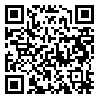BibTeX | RIS | EndNote | Medlars | ProCite | Reference Manager | RefWorks
Send citation to:
URL: http://irj.uswr.ac.ir/article-1-371-fa.html
Objectives: Among the most important problems of autistic children are the behavioral disorders due to sensory processing deficiency, which are typically reflected in behaviors such as impulsivity, attention and concentration disorders, undesirable emotional reactions, sensory seeking in the form of stereotype behaviors, self-injury and self-stimulating. The present study aimed at exploring the effects of a combined vestibular and tactile stimulation on behavioral abnormalities resulting from sensory processing deficiency in autistic children of an age of 3-13 years old.
Methods: The study was an experimental research using a pretest-posttest design with a control group. Twelve autistic children of an average age of 8.4 year whose sensory disorders had been verified through the Winnie Dunn’s Sensory Assessment Questionnaire, were randomly selected from two school for behavioral disorders. They were randomly grouped in two groups of 6 subjects, namely the Test Group and the Control Group. Then, participants in the experimental group received vestibular and tactile stimulation for 36 sessions, 3 sessions a week, each session of 45 minutes.
Results: The subjectsin the control group were under the school’s regular schedule. After intervention, they were assessed again and the collected data obtained were analyzed through Multivariable Covariance Analysis using the SPSS software, version 20.
Discussion: According to the findings obtained, the vestibular and tactile stimulation significantly decreases the behavioral abnormalities of autistic children afflicted with sensory processing deficiency (P<0.01). Using the vestibular and tactile stimulation can be taken as an effective method in the treatment of autistic children.
دریافت: 1392/6/16 | پذیرش: 1392/7/20 | انتشار: 1392/9/10



